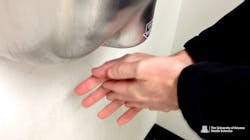Researchers evaluate effectiveness of paper towels vs. air hand dryers
The data outlining the benefits of electric warm air hand dryers in comparison with paper towels for drying hands after washing in public restrooms is conflicting and lacks key variables needed to assess human health risk, a University of Arizona (UArizona) Health Sciences research team concluded after reviewing nearly 300 papers and published studies on the topic, stated a news release from the university.
“Conclusions that have been drawn and promoted to the public are from incomplete data or from studies that lack rigor or real-world scenarios,” said Kelly A. Reynolds, MSPH, PhD, director of the Environment, Exposure Science and Risk Assessment Center at the UArizona Mel and Enid Zuckerman College of Public Health. “We found that some study authors extended general recommendations without sufficient scientific evidence. The fact is, the breadth of available data does not favor one hand-drying method as more hygienic or safer than the other.”
To clarify if a particular hand-drying method is more hygienic, investigators conducted a comprehensive review of studies on hand-drying methods, relative to hygiene and health risks. The research project, funded by Excel Dryer Inc., considered published scientific studies and “gray literature” on the topic. Gray literature includes unpublished or published research in non-commercial forms, such as government or academic reports, policy papers, white papers and other evaluations. Only 23 studies, about eight percent of the total, met criteria for inclusion based on scientific rigor – a score determined by evaluating such factors as sample size, methodology, data quality and whether the study was conducted in a real-world setting.
The final research project publication, “Comparison of Electric Hand Dryers and Paper Towels for Hand Hygiene: A Critical Review of the Literature,” evaluates an extensive range of previous research. The study was published in August in the Journal of Applied Microbiology.
The review undertook a broad analysis of a primary research question, “Are hand dryers more hygienic than paper towels?” A secondary question the team reviewed was, “Are paper towels safer than hand dryers, relative to human health risks?”
The collective data showed that neither hand drying method was more hygienic than the other. The inconclusive results found in the current body of research, as well as a lack of data to support health claims, prevent specific policy or practice recommendations on hand-drying protocols.
Dr. Reynolds noted that the most important thing to focus on in handwashing is technique – using soap, lathering all of the hands’ skin area, washing them for 20 to 30 seconds, and then drying the hands completely. That is the most effective way to prevent cross-contamination, whether you use an air dryer or a paper towel to dry your hands, she added.
A professor and chair of the Department of Community, Environment and Policy at the college, Dr. Reynolds co-authored the review study in collaboration with public health research colleagues, Jonathan Sexton, PhD, Ashton Norman and Jean McClelland.
